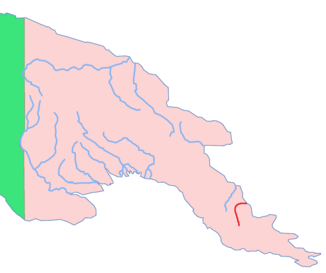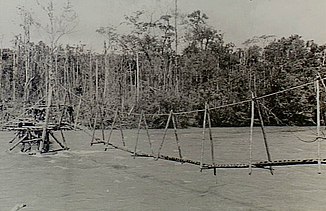Kumusi (river)
| Kumusi | ||
|
Location of the Kumusi River in Papua New Guinea |
||
| Data | ||
| location | Papua New Guinea | |
| River system | Kumusi | |
| Drain over | Solomon Sea → Pacific Ocean | |
| muzzle |
Solomon Sea coordinates: 8 ° 29 ′ 1 ″ S , 148 ° 13 ′ 31 ″ E 8 ° 29 ′ 1 ″ S , 148 ° 13 ′ 31 ″ E |
|
| Mouth height |
0 m
|
|
| length | 120 km | |
|
Aerial view of the Kumusi River |
||
|
Kumusi river crossing at Wairopi |
||
The Kumusi (also Kamusi ) is a river in the province of Oro in Papua New Guinea . It is known for its width and high flow speed. It was important to the history of Oro Province during the Kokoda Track Campaign in World War II and in 2007 because of the floods and damage caused by Cyclone Guba .
history
Second World War
Due to its relative proximity to the Kokoda Track , the Kumusi River repeatedly played an important role in the Kokoda Track Campaign during World War II . The fast flowing and wide river provided a natural barrier to the enemy and gave the defenders a distinct advantage. There were only a few bridges and the fixed bridges were often bombed to interrupt the supply lines. Therefore the soldiers had to cross the raging river mostly without aids or with rafts. The strong current resulted in many deaths. One of the most notable deaths was that of Japanese Major General Horii Tomitarō . After the Oivi-Gorari battle, the chaotic Japanese troops crossed the river at Wairopi . Although his horse had already drowned, Horii decided to cross the river on a raft. He fell into the water and drowned.
Cyclone Guba
On November 14th and 15th, 2007, cyclone Guba hit the province of Oro . The cyclone brought heavy rain for five days, which led to widespread flooding . The kumusi swelled up to ten times its original width. The floods destroyed houses, gardens and, in some cases, washed away entire villages. The floods completely destroyed the vital infrastructure of the province. Over 22 bridges were washed away and the connection to the capital of the province of Popondetta was cut.
Individual evidence
- ↑ Peter Brune: Those Ragged Bloody Heroes . Ed .: Allen & Unwin. 1992, ISBN 1-86373-264-0 , pp. 215 (English).
- ^ Peter Brune: A Bastard of a Place . Ed .: Allen & Unwin. 2004, ISBN 1-74114-403-5 , pp. 90 (English).
- ↑ Peter Brune: Those Ragged Bloody Heroes . Ed .: Allen & Unwin. 1992, ISBN 1-86373-264-0 , pp. 216 (English).
- ^ Peter Brune: A Bastard of a Place . Ed .: Allen & Unwin. 2004, ISBN 1-74114-403-5 , pp. 419 (English).
- ↑ Patrick Lindsay: The Spirit of Kokoda: Then and Now . Ed .: Hardie Grant Books. 2002, ISBN 1-74066-075-7 , pp. 122 (English).
- ^ ABM responds to PNG cyclone. Tasmanian Anglican, February 2008, accessed August 17, 2018 .
- ↑ Most recent disaster declaration: Papua New Guinea cyclone. In: usaid.gov. November 20, 2007, accessed August 17, 2018 .


